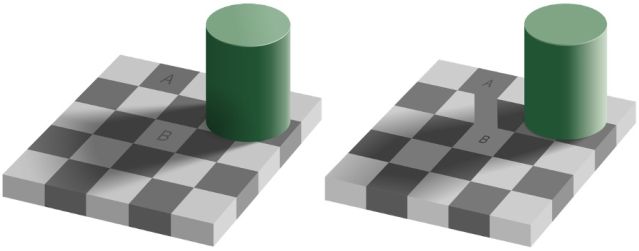Unconscious
Why Pink Doesn't Exist: Lessons in Perception and Reality
We don't access reality directly, just the brain's representation.
Posted May 29, 2023 Reviewed by Kaja Perina
Key points
- Sensation is our physiological response to the world around us: The sensory input we receive.
- Perception is how we experience sensory information after it has been analysed and interpreted by our brains.
- We cannot access the external reality directly but only our brains’ representations.
- Pink doesn’t exist in the external reality as a wavelength of light but exists as a perception in our minds.

Pink is a bright, bold, and happy colour with a long history. It’s been described in Homer’s Odyssey (800 BC) and was fashionable among the 18th-century upper class in Europe—both male and female—as a symbol of class, style, and luxury (Phillips, 2023). Elvis Presley drove a pink Cadillac and former first lady Mamie Eisenhower used pink extensively in her attire and with decorations in the White House (Phillips, 2023).
Here is the problem: Pink doesn’t exist.
If we ignore the strange world of quantum mechanics for a moment, light can be described as electromagnetic radiation that comes in different wavelengths. We perceive a narrow spectrum of this radiation as visible light. At the low end of the frequency spectrum1 is red light and at the high end is violet. Artists often use a colour wheel to show the relationships between colours.
The problem is that light comes on a spectrum that doesn’t connect at its ends. If we sort objects, like apples, on a spectrum from small to large, there are medium-sized apples in the middle. But we cannot combine the property of being large and small in a new way to create a big-small apple that is different from a medium-sized one. The same is true for colour: The middle-point between red and violet is somewhere in the green range but there isn’t any light that corresponds to the areas between red and violet on a colour wheel. In a way, these are imaginary colours (this is why there are no pink or magenta lasers).

Sensation and Perception
There is no light frequency or wavelength that corresponds to what we see as pink or magenta (Moyer, 2012). This fact led to the bizarre headline in Time Magazine stating that scientists aren’t sure if pink exists (Locker, 2012)2. For the record: Scientists know a great deal about light and about how we perceive it. We see shades of pink or magenta when we sense red and violet (or blue) light in close proximity. There really isn’t any scientific debate about that. However, this issue highlights a profound aspect about us as human beings: What we perceive is not the external world around us but our brain’s interpretation of it.
Sensation has traditionally been described as a single unit of experience produced by stimulating a sensory receptor. However, the current state of research doesn’t support this idea anymore because experiences and awareness do not come directly from sensory receptors. We can sense things without being aware of them (Pang & Elntib, 2021;2023) and as the colour pink shows, what we are aware of is not simply the sum of what our senses pick up.
Our experiences—or what we perceive—are the heavily processed and filtered interpretations our brains give us (Huth et al., 2012; Schapiro et al., 2013). Viewed this way, sensations are a physiological response to external stimuli. In simpler words, sensations are how our bodies respond to the world around us. Perception on the other hand is how we experience our world (APA, 2007b). Sensations can occur unconsciously but perception is directly linked to conscious experience and forms one of the key dimensions of consciousness (see The Many Dimensions of Consciousness; Pang, 2023a).
Perception and Reality
This view of perception is profound because it suggests that we have no direct access to the external reality around us. We only ever experience our brain’s internal representation of the outside world, which is limiting in two main ways:
Firstly, we only pick up a very small range of things. For example, we can only see a very narrow band of electromagnetic radiation—what we call visible light. X-rays, radio waves, or even microwaves are essentially the same as light, but they all have frequencies that are outside of what we can perceive.
Many animals have magnetoreception, which means that they can sense magnetic fields—a bit like having an internal compass (Kirschvink et al., 2001). We are intrinsically oblivious to this part of reality; there are no real estate ads that praise the lush or harmonious magnetic field of a home but many that exalt the view from the property. While we know about the Earth’s magnetic field, there could be many aspects of reality that we are completely ignorant of. We don’t even know what we don’t know.
Secondly, as we discovered earlier, our brains filter, correct, and interpret the overwhelming amount of sensory data we encounter (Huth et al., 2012; Schapiro et al., 2013). This is crucial for us to make sense of the world around us and act within a complex environment.
A good example of this is the checkerboard optical illusion, where we perceive two squares of the same colour to be different shades because of the shadow of a third object. Our perception may be inaccurate, but it is much more useful: We can tell that ‘B’ (see image below) is one of the “light” fields on the checkerboard. We also recognise the dark streak as a shadow and the object in the corner as a cylinder. We don’t perceive a matrix of colours but distinct objects in a three-dimensional space and their relationships to one another.

Qualia and “What is it Like…”
Our experiences, then, are different from what is actually out there in the world. This does not mean that an objective reality doesn’t exist, nor does it mean that what we experience is any less real—both are very real in their own sense—but it does mean that they are different. This is crucial when we talk about the mind and consciousness (see What is Consciousness?, Pang, 2023b).
Pink and magenta may not exist as a distinct wavelength of light (we can say that it doesn’t exist in the external reality) but there is a specific external configuration of light that make us perceive something as pink. So, the question of whether pink is real depends on whether we talk about our internal world of experience (where it’s very much real) or the external world (where it isn’t). Sadly, our conundrum about reality doesn’t end there. We can confidently say that a sound exists as vibrations travelling through the air. But why do vibrations sound like something to us? Why are some sounds pleasant and others dissonant? And why is experiencing a sound different from experiencing a colour?

Philosophers call these experiential qualities qualia (the singular form is quale). The American philosopher Thomas Nagel (1974) described experiences and consciousness as having a uniquely subjective aspect that he summed up in the question “What is it like to be something?” According to Nagel, being a bat has a distinct qualitative experience (it is like something to be a bat), whereas being a rock doesn’t have that (there is no “what it is like” associated with being a rock). Others have argued against the concept of qualia altogether (for example, Dennett, 1988).
Ultimate Reality
Regardless of where we find ourselves in this debate, our brief journey from pink to sensation and perception has shown us that our internal experience is different from our external world—both factually and qualitatively. Which one is real? I would argue that both are but in different ways. Despite massive advances in psychology and neuroscience, we still cannot fully explain our internal experience based on what we know of the external world (and some say we never will; Chalmers, 1995). We cannot convincingly do the reverse either (although some have tried, for example Kastrup, 2022). This means that any complete description of reality has to include both the experiential and the physical.
Facebook/LinkedIn image: KK_face/Shutterstock
References
1 Frequency is inversely related to wavelength (f = 𝜈/λ, where f is the frequency, 𝜈 is the wave speed, and λ is the wavelength): Red light has a low frequency but a large wavelength.
2 This was the result of two blog posts arguing the opposite: Krulwich (2012) on NPR and then a response by Moyer (2012) in the Scientific American.
American Psychological Association. (2007a). Sensation. In G. R. VandenBos (Ed.) APA Dictionary of Psychology. American Psychological Association.
American Psychological Association. (2007b). Perception. In G. R. VandenBos (Ed.) APA Dictionary of Psychology. American Psychological Association.
Chalmers, David (1995). Facing up to the problem of consciousness. Journal of Consciousness Studies, 2(3), 200–219.
Dennett, D. C. (1988). Quining qualia. Consciousness in contemporary science, 42-77.
Huth, A. G., Nishimoto, S., Vu, A. T., Gallant, J. L. (2012). A Continuous Semantic Space Describes the Representation of Thousands of Object and Action Categories across the Human Brain. Neuron, 76(6), 1210-1224. https://doi.org/10.1016/j.neuron.2012.10.014
Kastrup, B. (2022). Reality is not what it seems. IAI News. https://iai.tv/articles/reality-is-not-what-it-seems-auid-2312
Kirschvink, J. L., Walker, M. M., & Diebel, C. E. (2001). Magnetite-based magnetoreception. Current opinion in neurobiology, 11(4), 462-467. https://doi.org/10.1016/S0959-4388(00)00235-X
Krulwich, R. (2012, Mar 02). They did it to Pluto, but not to pink! Pleae not pink! NPR. https://www.npr.org/sections/krulwich/2012/02/28/147590898/they-did-it-to-pluto-but-not-to-pink-please-not-pink
Locker, M. (2012). Does the color pink exist? Scientists aren’t sure. Time. https://newsfeed.time.com/2012/03/07/does-the-color-pink-exist-scientists-arent-sure/
Moyer, M. (2012, Mar 12). Stop this absurd war on the color pink. Scientific American. https://blogs.scientificamerican.com/observations/stop-this-absurd-war-on-the-color-pink/
Nagel, T. (1974). What is it like to be a bat? The Philosophical Review, 83(4), 435-450. https://doi.org/10.2307/2183914
Pang, D. K. F. (2023a). The many dimensions of consciousness. Psychology Today. https://www.psychologytoday.com/intl/blog/consciousness-and-beyond/202305/the-many-dimensions-of-consciousness
Pang, D. K. F. (2023b). What is consciousness? Psychology Today. https://www.psychologytoday.com/intl/blog/consciousness-and-beyond/202305/what-is-consciousness
Pang, D. K. F., & Elntib, S. (2021). Strongly masked content retained in memory made accessible through repetition. Scientific reports, 11(1), 10284. https://doi.org/10.1038/s41598-021-89512-w
Pang, D. K. F., & Elntib, S. (2023). Further evidence and theoretical framework for a subliminal sensory buffer store (SSBS). Consciousness and Cognition, 107, 103452. https://doi.org/10.1016/j.concog.2022.103452
Phillips, K. (2023). The color pink—history, meaning, and facts. Hunter Lab. https://www.hunterlab.com/blog/the-color-pink/
Schapiro, A., Rogers, T., Cordova, N. et al. (2013). Neural representations of events arise from temporal community structure. Nature Neuroscience, 16(4), 486–492. https://doi.org/10.1038/nn.3331




